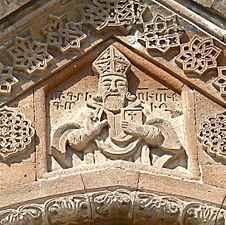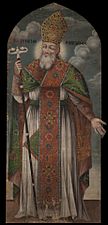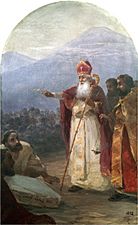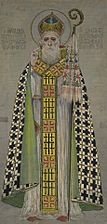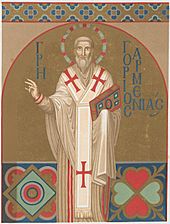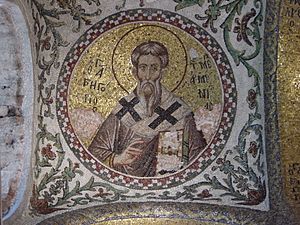Gregory the Illuminator facts for kids
Quick facts for kids SaintGregory the Illuminator |
|
|---|---|
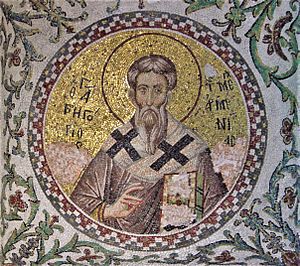
A 14th century Byzantine mosaic of Gregory at the Pammakaristos Church in Constantinople (today Fethiye Camii, Istanbul)
|
|
| Catholicos of All Armenians (Patriarch of Armenia) |
|
| Born | 3rd century Kingdom of Armenia |
| Died | c. 328 Daranali, Kingdom of Armenia (present-day Kemah, Erzincan, Turkey) |
| Venerated in | Armenian Apostolic Church Oriental Orthodox Churches Catholic Church Eastern Orthodox Church Anglican Communion |
| Feast | February 20 (Nardò, Italy) March 23 (Anglican Church) Saturday before fourth Sunday after Pentecost (Armenian Apostolic Church - discovery of relics) Last Saturday of Lent (Armenian Apostolic Church - descent into dungeon) Saturday before second Sunday after Pentecost (Armenian Apostolic Church - deliverance from dungeon) September 30 (Eastern Orthodoxy; Catholic Church, Oriental Orthodoxy,Ordinary Form), October 1 (Catholic Church, Extraordinary Form) |
| Patronage | Armenia; Nardò, Italy |
Gregory the Illuminator (born around 257, died around 328) was a very important religious leader. He was the first head of the Armenian Apostolic Church. He helped Armenia become the first country to make Christianity its official religion. This happened in the early 300s. Because of his great work, he is honored as a saint in many churches.
Gregory's story says he was the son of a nobleman named Anak. Anak was from Parthia, a powerful ancient kingdom. Anak assassinated King Khosrov II of Armenia. Young Gregory was saved from his family being killed. He was raised as a Christian in a city called Caesarea.
When Gregory grew up, he returned to Armenia. He began working for King Tiridates III, who was the son of the king Anak had killed. Gregory refused to worship pagan gods. Because of this, King Tiridates had him tortured. When the king found out who Gregory really was, he threw him into a deep pit called Khor Virap.
Gregory was miraculously saved from death in the pit. After many years, he was released. This happened with help from Tiridates' sister, Khosrovidukht. Gregory then healed King Tiridates. The king, who had been very ill, then accepted Christianity. Gregory taught Christianity throughout Armenia. He became a bishop and baptized the king and the Armenian people. He traveled, destroying old pagan temples and building churches.
Later, Gregory decided to live a quiet life as a hermit. His son, Aristaces, took over as the head of the church. Gregory's family, called the Gregorids, led the Armenian Church for a long time. The Armenian Church is sometimes called "Gregorian" in his honor.
Contents
Gregory's Early Life
The main story of Gregory comes from a history written in the 400s. It says Gregory was the son of Anak, a Parthian nobleman. Anak assassinated King Khosrov II of Armenia. This was at the request of the Sasanian king. After the assassination, Anak and his family were supposed to be killed. But young Gregory escaped with the help of his nurse.
Gregory was taken to Caesarea in Cappadocia. There, he was raised as a Christian. When he became an adult, Gregory married a Christian woman named Mariam. They had two sons, Aristaces and Vrtanes. Both of his sons later became leaders of the Armenian Church.
Armenia Becomes Christian
After his sons were born, Gregory and Mariam separated. Gregory then went to Armenia. He began to serve King Tiridates III. This king was the son of Khosrov II, whom Gregory's father had killed. Gregory refused to worship the goddess Anahit. So, the king had him put in prison and tortured.
When King Tiridates learned Gregory was the son of his father's killer, he threw Gregory into a deep pit. This pit was called Khor Virap. Gregory stayed there for 13 or 15 years. The story says Gregory was saved by a miracle. King Tiridates' sister, Khosrovidukht, had a vision. She helped get Gregory out of the pit.
Gregory then healed the king. The king had been very sick, and the stories say he was transformed into a wild boar. After being healed, King Tiridates and his court accepted Christianity. This made Armenia the very first country to officially adopt Christianity.
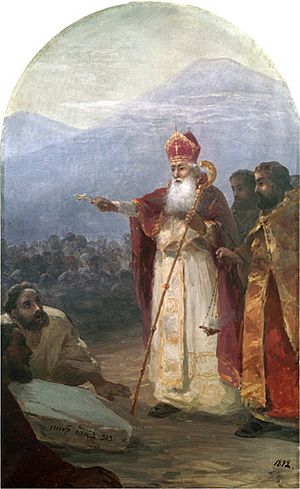
After his release, Gregory traveled around Armenia. He taught people about Christianity. He built churches where pagan temples used to be. He also set up shrines for Christian martyrs. One important place was Vagharshapat, where the main church of Armenia, Etchmiadzin Cathedral, was later built.
Gregory went to Caesarea and became the bishop of Armenia. He then returned to Armenia. He continued to build churches and establish the church's structure. He baptized King Tiridates, the army, and the people in the Euphrates River. He also started schools to teach children about Christianity. These schools taught in Greek and Syriac.
The conversion of Armenia to Christianity is traditionally said to be in 301 AD. However, many historians now think it happened a bit later, around 314 AD. The spread of Christianity was also a gradual process, not just a single event.
Retirement and Death
After helping Armenia become Christian, Gregory chose to live a quiet life. He appointed his younger son, Aristaces, to take his place. Gregory went to live as an ascetic in a cave. This was in a region called Daranali. His family, the Gregorids, continued to lead the Armenian Church for many years.
Gregory sometimes left his hermitage to travel. But after his son Aristaces returned from an important church meeting (the Council of Nicaea in 325 AD), Gregory stayed in seclusion. He died in his cave and was buried by shepherds. They did not know who he was. Most sources say he died around 328 AD.
Relics and Veneration
After Gregory's death, his body was moved to a village called Thodanum. Many churches claim to have parts of his relics. For example, the Mother See of Holy Etchmiadzin and the Holy See of Cilicia each say they have his right arm. This arm is used to bless special holy oil every seven years.
The Armenian Church celebrates several feast days for Saint Gregory. One day remembers the discovery of his relics. Two other days celebrate his entry into and deliverance from the deep pit, Khor Virap.
- Armenian depictions of Gregory
Gregory in the Orthodox World
During the rule of Emperor Zeno, Gregory's relics were spread to many places. People in the Byzantine Empire began to honor Gregory in the late 800s. A mosaic of Gregory was found in the Hagia Sophia church in the 1800s. It shows Gregory in bishop robes, holding a cross and a Bible.
Gregory is also shown in old Byzantine manuscripts and churches. These include the Menologion of Basil II and the Theodore Psalter. The Eastern Orthodox Church celebrates his feast day on September 30. They call him "Holy Hieromartyr Gregory, Bishop of Greater Armenia, Equal of the Apostles and Enlightener of Armenia."
- Byzantine depictions of Gregory
-
A mosaic at Hagia Sophia (9th century)
Gregory in the Catholic World
In the 700s, some religious groups fled the Byzantine Empire. They went to Italy. The church of San Gregorio Armeno in Naples was built by nuns who brought Gregory's relics. These relics included his skull and bones. Some of these relics were later returned to Armenia by Pope John Paul II. They are now in the Saint Gregory the Illuminator Cathedral in Yerevan.
On February 20, 1743, a big earthquake hit Nardò, Italy. Almost the whole city was destroyed. But a statue of Saint Gregory the Illuminator was the only thing that survived. Only 350 people died out of 10,000. The people of Nardò believed Saint Gregory saved their city. Every year, they celebrate him for three days. Relics of the saint are kept in the Nardò Cathedral.
The Catholic Church celebrates Saint Gregory on September 30 or October 1. The Episcopal Church in the USA celebrates him on March 23.
A large statue of Gregory was placed in St. Peter's Basilica in Vatican City in 2005. It is about 5.7 meters (18.7 feet) tall. The statue shows Gregory holding a cross and the Bible. Pope Benedict XVI later named the area "St. Gregory the Illuminator Courtyard."
Images for kids
See also
 In Spanish: Gregorio I el Iluminador para niños
In Spanish: Gregorio I el Iluminador para niños
- Eastern Christianity
- Gregorids
- Vardapet, Armenian preaching monks



